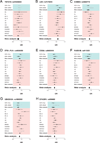High-density genotyping of immune loci in Koreans and Europeans identifies eight new rheumatoid arthritis risk loci
- PMID: 24532676
- PMCID: PMC4467986
- DOI: 10.1136/annrheumdis-2013-204749
High-density genotyping of immune loci in Koreans and Europeans identifies eight new rheumatoid arthritis risk loci
Abstract
Objective: A highly polygenic aetiology and high degree of allele-sharing between ancestries have been well elucidated in genetic studies of rheumatoid arthritis. Recently, the high-density genotyping array Immunochip for immune disease loci identified 14 new rheumatoid arthritis risk loci among individuals of European ancestry. Here, we aimed to identify new rheumatoid arthritis risk loci using Korean-specific Immunochip data.
Methods: We analysed Korean rheumatoid arthritis case-control samples using the Immunochip and genome-wide association studies (GWAS) array to search for new risk alleles of rheumatoid arthritis with anticitrullinated peptide antibodies. To increase power, we performed a meta-analysis of Korean data with previously published European Immunochip and GWAS data for a total sample size of 9299 Korean and 45,790 European case-control samples.
Results: We identified eight new rheumatoid arthritis susceptibility loci (TNFSF4, LBH, EOMES, ETS1-FLI1, COG6, RAD51B, UBASH3A and SYNGR1) that passed a genome-wide significance threshold (p<5×10(-8)), with evidence for three independent risk alleles at 1q25/TNFSF4. The risk alleles from the seven new loci except for the TNFSF4 locus (monomorphic in Koreans), together with risk alleles from previously established RA risk loci, exhibited a high correlation of effect sizes between ancestries. Further, we refined the number of single nucleotide polymorphisms (SNPs) that represent potentially causal variants through a trans-ethnic comparison of densely genotyped SNPs.
Conclusions: This study demonstrates the advantage of dense-mapping and trans-ancestral analysis for identification of potentially causal SNPs. In addition, our findings support the importance of T cells in the pathogenesis and the fact of frequent overlap of risk loci among diverse autoimmune diseases.
Keywords: Ant-CCP; Gene Polymorphism; Rheumatoid Arthritis.
Published by the BMJ Publishing Group Limited. For permission to use (where not already granted under a licence) please go to http://group.bmj.com/group/rights-licensing/permissions.
Figures



References
-
- Scott DL, Wolfe F, Huizinga TW. Rheumatoid arthritis. Lancet. 2010;376:1094–1108. - PubMed
-
- MacGregor AJ, Snieder H, Rigby AS, et al. Characterizing the quantitative genetic contribution to rheumatoid arthritis using data from twins. Arthritis Rheum. 2000;43:30–37. - PubMed
-
- Okada Y, Terao C, Ikari K, et al. Meta-analysis identifies nine new loci associated with rheumatoid arthritis in the Japanese population. Nat Genet. 2012;44:511–516. - PubMed
Publication types
MeSH terms
Grants and funding
LinkOut - more resources
Full Text Sources
Other Literature Sources
Medical
Miscellaneous

